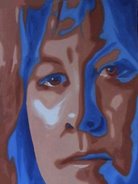During the workshop, every day brought a new set of challenges. Everyone's pots cracked, and continued to crack the entire week. I brought my pots home, wrapped them tightly, and let them dry very slowly. They were fine for a couple of weeks, but then they, too, developed large cracks. I decided that they weren't meant to be, so I'll crush them and add them to the outer layer of my horno. However, a handful of my tiny pinch pots survived (above), if only for now. I don't generally photograph a work until it's complete, and these little pots still need to be fired. But since I don't know whether or not they'll make it through the firing, I wanted to photograph them as a reminder of my workshop with Clarence.
Occasionally, someone would lament the cracked pots or some other problem, and Clarence would reply, "Process. It's all about the process." And he's right. We can't get from here to there withouth the journey. And the journey is process.
I love the color of clay. And something that I've enjoyed working on the past month is turning dried clay, and other rocks & minerals into slip. I'll use this slip to decorate my pots.
 After soaking the rocks for many days, I crushed them and added more water to make a paste. The paste was then soaked some more to make slip.
After soaking the rocks for many days, I crushed them and added more water to make a paste. The paste was then soaked some more to make slip.The orange rocks (above) came from Hayden Quarry. They were quite pretty, as is, with their little bits of quartz crystal. After a good soaking, and some brute force, I was able to break them up and then crush them. A little water added to the mix yielded a thick paste, which I then added to more water to make slip. This had to soak for a few days before I sieved it.
 Chunks of clay from the Late Triassic Period await processing
Chunks of clay from the Late Triassic Period await processingI followed this procedure with some white and red clay that I picked up from the same quarry. These are the rocks and clay that surrounded the dinosaur bones we excavated back in June, so I like to imagine that I'm working with materials that were once touched by pre-human fauna.
 White, tan, orange, and red slips are ready for use.
White, tan, orange, and red slips are ready for use.And finally, the finished product (above). Today I'm going to make some test tiles, paint them with my new slips, burnish them to a high gloss, and then put them into the next firing. I already know that they're going to be gorgeous.
One of the slips (above, second from left) was made from the clay that Clarence gave me. Whenever I use it, or any of the others that have kept me busy for the past month, I'll fondly remember my time with Clarence, and his reminder that it's all about the process.
One of the slips (above, second from left) was made from the clay that Clarence gave me. Whenever I use it, or any of the others that have kept me busy for the past month, I'll fondly remember my time with Clarence, and his reminder that it's all about the process.


















































